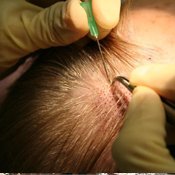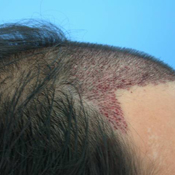!


The Procedure
Depending on the treatment method applied, a patient may need to stay in Istanbul from one up to four days.
Before the procedure
Within one or two week before a hair transplant surgery it is advisable for you to avoid: dying your hair, using hair growth treatments and products, taking Aspirin or any other medications known to reduce blood coagulation. Vitamins B and E may increase bleeding therefore avoid multivitamins that contain them. You should also refrain from or limit significantly the amount of smoking 24 hours prior to procedure. Cigarettes tend to delay the recovery and increase the risk for infection and scars. Reduce alcohol consumption to minimum three days before the treatment. People wearing hair replacements such as hairpieces, wigs or toupees should remove them one week prior to the procedure. It is also advisable no to cut your hair before the operation so that the hair in the donor area can have the required density.
One to three days before the procedure you should take a complete rest and cease any strenuous activities. It is desirable during the same period to stop using hair sprays, gels or mousses, as well as skin creams such as Retin-A. Washing your hair with an antibacterial shampoo or soap is a must. In some case antibiotics may be prescribed to reduce the risk of infection. On surgery day wear comfortable clothes and avoid caffeine products such as coffee. Keep in mind that you won’t get a chance to go to bathroom during the treatment so have a light snack and make use of the WC before entering the operation room.
The preliminary examinaton
During your first consultation in our clinic, your head will be examined thoroughly by an expert physician. By means of a Hair Densitometer the doctor will carefully measure the hair density in the donor area and will determine the progression of hair loss. In addition the rate of hair loss will be projected and according to your pattern baldness, the characteristics of your skin and hair, and the amount of donor hair you can spare, the doctor will recommend the most appropriate transplantation method for you. The hair transplant procedure will be scheduled and explained in detail as well as the results that you can expect.
The procedure
Prior to the surgery a simple local anaesthesia is applied to both the donor and the recipient area so that patient feels no pain during treatment. The hair density of follicular units in the donor area is measured up per cm2 in order the appropriate quantity of donor hair to be obtained. Depending on the degree of baldness, the colour, thickness and coarseness of the hair, the surgeon determines the size, the shape and number of grafts needed for the transplantation. Normally, coarse lighter hair such as gray or blonde usually provides better results compared to fine darker hair. Up to the hair transplant technique used, the donor hair will be collected through an incision of a strip of fixed hair-bearing skin from the back of the scalp (FUT method) or extracted one by one by means of a pen-like instrument called ‘punch’ (FUE method). Before the FUE technique the donor area may be trimmed short so that the donor grafts can be easily removed. Once removed the donor hair is dismantled under a microscope into follicular units or micro-minigrafts which later are planted into the areas of baldness. Up to the number of grafts to be transplanted, it takes between three and eight hours for the procedure to be completed. Depending on how advanced the stage of hair loss is, between 1000 and 2500 follicular units can be transplanted in one single procedure.
After the procedure
Following the procedure, the patient may go back to his/her daily routine usually the very same day. Minor discomfort such as swelling, headache or minor bleeding at the donor area could be experienced during the first two days. In cases of swelling ice compresses can be applied. Tiny crusts may be formed around the newly planted grafts, but these will fall off in a couple of weeks. You may be given a medical lotion to rub onto those places until crusts shed off completely. A pressure bandage may be applied for nearly one week after the surgery to prevent the operated area from swelling or infection.
You can wash your hair on the day after the hair transplant surgery, however you should avoid dying it for a period of 6 weeks after that. You may brush or comb your hair however without exercising pressure to the affected area. During the first few days of the procedure you should refrain from alcohol consumption and exhausting activities. Avoid strenuous activities and sports for 3 weeks. Light exercises are allowed 2 weeks after the procedure. Cease or reduce heavy smoking until sutures are taken off. Keep your head from traumas and avoid scratching your scalp. You need to give up saunas, solariums or natural sunbathing for almost 2 weeks. When exposed to a sun please wear a hat. When cutting your hair avoid using electric razors for the first six months.
Results
You may notice the transplanted hair falling off within one or two months after the surgery due to the insufficient oxygen delivered to the roots. The transplanted follicular roots will remain latent for a period of one to three months. When the latent period is over, they will resume production of new strands of hair that will continue its lifetime growth. Satisfactory results can be attained within a period of 8 month till one year following the procedure, since the normal rate of hair growth is approximately 1 cm per month.
